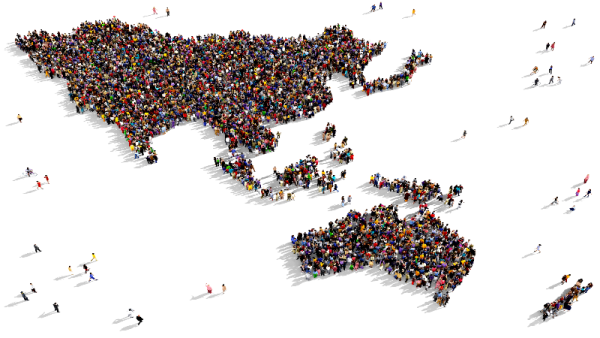Australia-China monthly wrap-up: November 2020
Arthimedes / Shutterstock

Elena Collinson, Senior Project and Research Officer, Australia-China Relations Institute, University of Technology Sydney |

James Laurenceson, Director, Australia-China Relations Institute, University of Technology Sydney |
Despite what appeared to be a cautious but concerted push by senior Australian government ministers towards the end of this month to ease political tensions with the People’s Republic of China (PRC), cool-headedness was subsequently abandoned following an undiplomatic Twitter missive from the PRC Foreign Ministry on Twitter slurring the Australian Defence Force. In the short to medium term it is unlikely that Beijing will be prepared to tone down its rhetoric and soften its strident stance, which means Canberra will need to meet this new reality squarely. Former ASIO and Defence head Dennis Richardson, observed in early November that Australia must be prepared to remain ‘in the doghouse for a good two to three years’.
In a series of belligerent press conferences by its Foreign Ministry, the PRC stepped up its vocal insistence that the onus is entirely on Australia to repair the bilateral relationship. Its officials repeatedly stated that ‘the root cause for the deteriorating China-Australia relations is Australia's repeated wrong acts and remarks’, asserting, ‘Let him who tied the bell on the tiger take it off. One's fault should be amended by oneself’.
There were some signs that Australia was making some attempt to get the relationship back on track without capitulating on any front. On November 10, for example, Prime Minister Scott Morrison floated the idea of a travel bubble with some parts of the PRC. Treasurer Josh Frydenberg on November 18 told a strategic forum, ‘We stand ready to engage with the Chinese government in respectful, mutually beneficial dialogue’. And, significantly, in a November 23 speech to the UK Policy Exchange the Prime Minister emphasised that ‘Australia is not and has never been in the economic containment camp on China’, saying:
I think one of the key misunderstandings is a level of confidence about what we see as the end result. Our end result from Australia's point of view, as I said, is not containment, our end result is happy coexistence, respecting each other's sovereignty and systems and being able to happily coexist in a mutually beneficial relationship.
The following day, the PRC Foreign Ministry said the Prime Minister’s speech had been noted: ‘China noticed Prime Minister Morrison's positive comments on the global influence of China's economic growth and China's poverty alleviation efforts’.
Prime Minister Morrison also encouraged Australian public servants on November 25 to ‘keep up the connections [with the PRC] and do all you can to improve them and keep the dialogue going at that level’.
But despite these Australian forays into a kind of tentative rapprochement, the PRC have remained by and large unmoved, stepping up trade restrictions on Australian imports and ramping up incendiary rhetoric.
Australian live lobster imports were left stranded on the tarmac in various PRC airports at the beginning of November due to a purported increased level of import inspections. The PRC’s General Administration of Customs suspended imports of Victorian timber from November 11 ‘after detecting pests’, with Queensland timber having been suspended from October 31 for the same broad issue. And following preliminary findings on an anti-dumping investigation, ‘anti-dumping security deposits’ – effectively tariffs – on Australian wine imports between 107 percent to more than 200 percent will have to be paid from November 28. Tensions have also extended to the Australian gas industry, with PRC buyers pulling out of a potential deal to purchase a stake in Woodside Petroleum’s $16 billion Scarborough project.
The sudden flurry of restrictions over the past year seem to have served a sort of dual purpose for the PRC. First, to punish Australia over political disagreements, using technical issues as a veneer. The Trade Minister had observed, ‘there has been a consistent theme of these sorts of technical issues in relation to what we would usually consider to be safe and reliable Australian product’. And perhaps second, to accelerate the creation of a more self-sufficient domestic economy in line with its latest Five Year Plan.
In a significant escalation on the diplomatic front, a PRC embassy official during a briefing with an Australian reporter on November 17 said, ‘China is angry. If you make China the enemy, China will be the enemy’, an echo of a formulation by former Australian foreign minister Alexander Downer in 2012 and again in 2020. A list of 14 grievances that ‘poisoned’ the bilateral relationship was subsequently provided to the Australian media by unnamed PRC embassy officials. These included Australia’s:
- Foreign investment rejections
- Huawei and ZTE ban
- Foreign interference legislation
- Revocation of visas for two mainland Chinese scholars
- Call for an international, independent inquiry into COVID-19
- Statements against the PRC government’s actions in Xinjiang, Hong Kong and Taiwan
- Statement on the South China Sea to the United Nations
- ‘Siding with the US’ anti-China campaign’
- Introduction of new foreign relations powers
- Provision of government funding for the Australian Strategic Policy Institute
- Raids on mainland Chinese journalists homes
- Statements on PRC-coordinated cyber attacks
- ‘Condemnation of the governing party of China by MPs and racist attacks against Chinese or Asian people’
- Critical media reports on the PRC
In the wake of the list’s publication, Prime Minister Morrison asserted, ‘Australia will always be ourselves. We will always set our own laws and our own rules according to our national interests – not at the behest of any other nation, whether that’s the US or China or anyone else’. At the same time, he said, ‘Australia is not seeking to make an enemy of any country, least of all…China’. Foreign Minister Marise Payne was even more unequivocal: ‘China is absolutely not the enemy. Very far from it’.
While the Australian side was circumspect in the face of the grievances list, tensions were likely further compounded by the intervention of US Ambassador to Australia Arthur B. Culvahouse, who told media, ‘You would never see a United States embassy hand such a list to a reporter in Australia. That is not the way to do diplomacy and it's not the way that one should deal with concerns. It should be done government to government. That sort of interference I don't think you would see in the United States’.
The PRC’s use of the Australian media to publicise their list of grievances, described by one Australian official as a ‘very familiar recitation of grievances and false statements’, in this manner could be construed as an attempt at applying pressure on the Australian government to reverse their positioning. More likely, however, it serves as a warning to other countries.
Australia was noticeably less cool-headed in its reaction to a Twitter attack by the PRC’s Foreign Ministry on the Australian Defence Force on November 30. The matter was elevated when Prime Minister Scott Morrison responded, describing the post as ‘truly repugnant’, ‘deeply offensive’ and ‘utterly outrageous’ and calling on the PRC government to apologise.
Given this latest ruction, it is unclear what will come next in the bilateral relationship. Australia will inevitably come up against more difficulties, caught as it is in the wake of strategic competition between the US and the PRC. As Defence Minister Linda Reynolds said in a November 20 speech, ‘[W]e are now facing the most consequential strategic realignment since the end of World War Two’ and ‘We have entered a critical phase in our nation’s economic and strategic history’. In his November 23 speech Prime Minister Morrison also asked for ‘greater latitude…from the world’s largest powers to accommodate the individual interests of their partners and allies’, saying, ‘We all need a bit more room to move’. This has clearly been disregarded by Beijing, and is likely to be given a similar treatment by the US given its intent under a new administration under the recently-elected Joe Biden – articulated by Secretary of State nominee and long-time Joe Biden advisor, Tony Blinken – to ‘start by putting ourselves in a position of strength from which to engage China so that the relationship moves forward more on our terms than on theirs’.
The annual total value of Australia’s goods exports to the PRC remained stable in September. Buoyant mainland Chinese demand for iron ore offset significant falls in coal and LNG.
Preliminary data for goods exports to the PRC in October show a 7.4 percent increase on the September figures, again driven by iron ore. In the year to October, the total value of goods exports to the PRC is only down by 1.3 percent on the same period in 2019. Meanwhile, exports to all other countries are down by 11.9 percent. The combined effect is the PRC’s share of Australia’s goods exports has hit a new record high of 40.6 percent, up from 38.1 percent last year.
New services export data show the effects of COVID-19 border closures. After finishing 2019 at a record high of $19.3 billion, this fell to $16.2 billion in 2019-2020.
Key trade indicators table - November 2020
Authors
Elena Collinson, Senior Project and Research Officer, Australia-China Relations Institute, University of Technology Sydney
Professor James Laurenceson, Director, Australia-China Relations Institute, University of Technology Sydney

